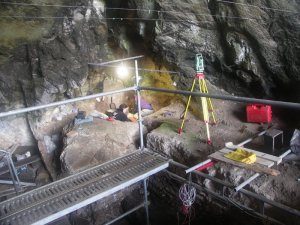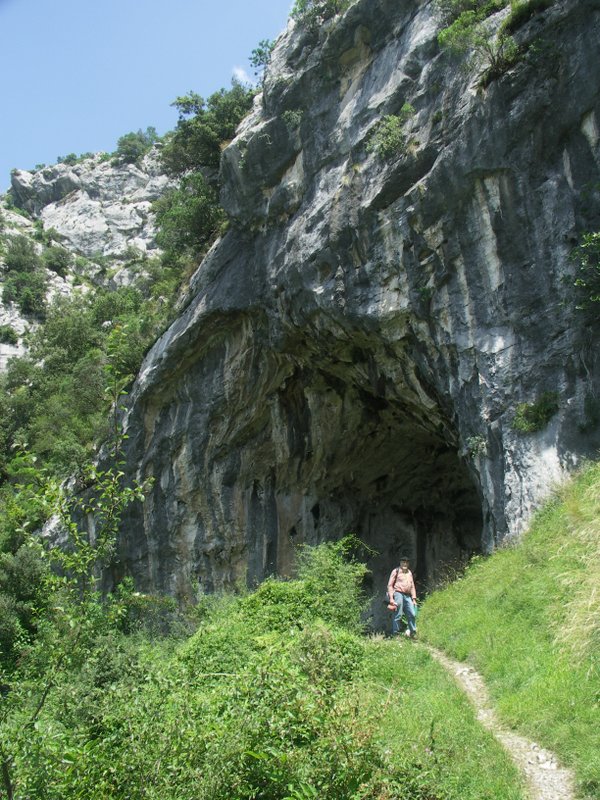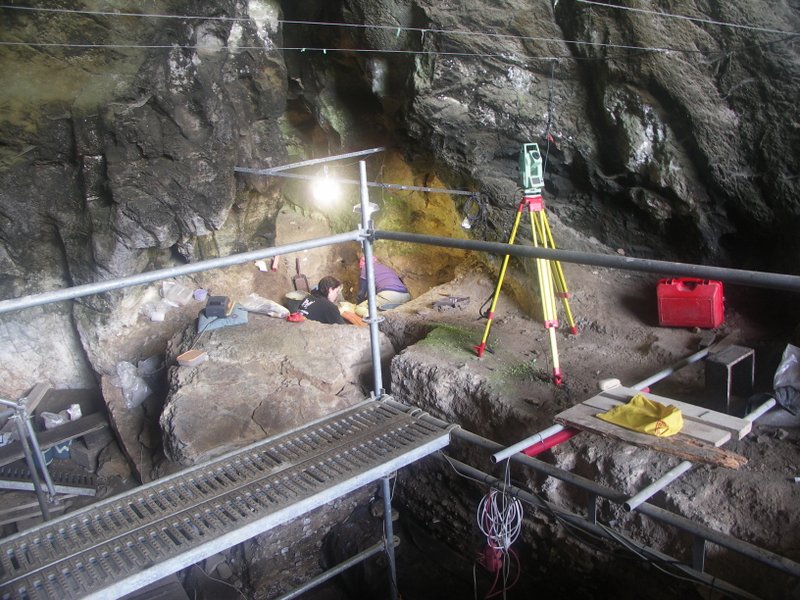 KONICA MINOLTA DIGITAL CAMERA
KONICA MINOLTA DIGITAL CAMERA The El Mirón Cave in the Cantabrian Mountains of northern Spain is yielding finds that are providing a rare glimpse of Ice Age life more than 18,000 years ago, say archaeologists.
The cave, commanding a scenic view of the upper valley of the Ason River far below it, has been under intense investigation by Lawrence Straus of the University of New Mexico and colleague Manuel Gonzalez Morales of the Universidad de Cantabria, since 1996.
“No one had ever done any work there since it was scientifically identified as a site in 1903, as archeologists believed it to be totally disturbed,” says Straus. “It was being used to stable goats. In 1995 I persuaded my old friend and colleague, Prof. Manuel Gonzalez Morales that we ought to conduct a test excavation in it, which we began in 1996.”
Since then, their findings have revealed a veritable gold mine of human occupation. El Mirón contains a long, essentially complete cultural sequence beginning with the late Middle Paleolithic through the early Bronze Age, dated using as many as 84 radiocarbon assays. Among the features and finds are rock art engravings and especially rich Magdalenian and Neolithic occupation levels. Within the Neolithic alone, according to Straus, is “the oldest evidence of wheat agriculture, domesticated animals and ceramics in northern Atlantic Spain”.
From the analysis of the excavated evidence, researchers have been able to tease a picture of Lower Magdalenian culture and behavior. But perhaps the most tantalizing discovery came when they encountered red ochre-stained bones in a natural depression in the rear of the cave living area. They were found within a 1-meter-wide space between the cave wall and a large block of stone and were identified as belonging to a human female, about 35-40 years old, robustly built and in good health. Dated to about 18,700 calendar years BP, the bones were deposited in a way that suggested intentional burial—an unusual find, particularly as the archaeological record thus far has suggested that the Magdalenians rarely buried their dead in the caves where they lived.
Perhaps most significant about the burial was the presence of features that suggested something more than a simple, quick and casual interment. Said Straus, “the burial seems to have been “marked” by engravings—a multi-line ‘V’ and other signs that could possibly be hands—on a huge stone block that had fallen from the cave ceiling only a few centuries before the burial.” In addition, according to the published report of the findings, there were lines engraved on the bedrock lower wall and ledge against which the body had been laid behind the stone block.
Straus states that the burial findings indicate “a complex, no doubt ritualized sequence of events”, not typically found in the prehistoric deposits of human remains. He suggests the possibility that it is a human grave containing a person of some status, who was perhaps revered or respected by her family or contemporaries.
____________________________________
 Excavations in the El Mirón Cave have yielded a cultural sequence of Late Mousterian, early Upper Paleolithic, Solutrean, Magdalenian, Azilian, Mesolithic, Neolithic, Chalcolithic, Bronze Age, and Medieval period occupation. The research has provided new insight on the Middle-Upper Paleolithic transition, the phases of the Magdalenian culture, the emergence of the Neolithic in the Atlantic zone of Spain, and the beginning of metal age cultural complexity. Image courtesy Lawrence G. Straus
Excavations in the El Mirón Cave have yielded a cultural sequence of Late Mousterian, early Upper Paleolithic, Solutrean, Magdalenian, Azilian, Mesolithic, Neolithic, Chalcolithic, Bronze Age, and Medieval period occupation. The research has provided new insight on the Middle-Upper Paleolithic transition, the phases of the Magdalenian culture, the emergence of the Neolithic in the Atlantic zone of Spain, and the beginning of metal age cultural complexity. Image courtesy Lawrence G. Straus
________________________________________________
 Inside the cave: Excavation in the burial area behind the engraved block. Courtesy Lawrence G. Straus
Inside the cave: Excavation in the burial area behind the engraved block. Courtesy Lawrence G. Straus
_________________________________________________
Straus and his colleagues are continuing their excavations and research of the site. He stresses that there is much more to do before additional conclusions can be drawn about El Mirón and its place in understanding the ancient Lower Magdalenian culture. Research will include a complete DNA analyses on the “Red Lady” skeletal remains by a team working with Dr. Svante Pääbo of the Max Planck Institute in Leipzig, with the goal of shedding light on the genetics of human populations that had survived the Last Glacial Maximum in southern France and Iberia.
An in-depth feature article about the “Red Lady of El Miron” has been published in Popular Archaeology Magazine and extensive details of the research are published as a special issue of the Journal of Archaeological Science (guest edited by L.G.Straus, M.R. Gonzalez Morales and J.M. Carretero): “The Red Lady of El Miron Cave: Lower Magdalenian Human Burial in Cantabrian Spain”. The issue features 13 related articles, all of which are now available on-line and released in a hard-copy version during the summer of 2015.
______________________________________________________
 Read more in-depth articles about archaeology with a premium subscription to Popular Archaeology Magazine.
Read more in-depth articles about archaeology with a premium subscription to Popular Archaeology Magazine.
In addition, the latest Popular Archaeology ebook is now available.
______________________________________________
Travel and learn with Far Horizons.
____________________________________________
 Popular Archaeology’s annual Discovery Edition eBook is a selection of the best stories published in Popular Archaeology Magazine in past issues, with an emphasis on some of the most significant, groundbreaking, or fascinating discoveries in the fields of archaeology and paleoanthropology and related fields. At least some of the articles have been updated or revised specifically for the Discovery edition. We can confidently say that there is no other single issue of an archaeology-related magazine, paper print or online, that contains as much major feature article content as this one. The latest issue, volume 2, has just been released. Go to the Discovery edition page for more information.
Popular Archaeology’s annual Discovery Edition eBook is a selection of the best stories published in Popular Archaeology Magazine in past issues, with an emphasis on some of the most significant, groundbreaking, or fascinating discoveries in the fields of archaeology and paleoanthropology and related fields. At least some of the articles have been updated or revised specifically for the Discovery edition. We can confidently say that there is no other single issue of an archaeology-related magazine, paper print or online, that contains as much major feature article content as this one. The latest issue, volume 2, has just been released. Go to the Discovery edition page for more information.
____________________________________________







